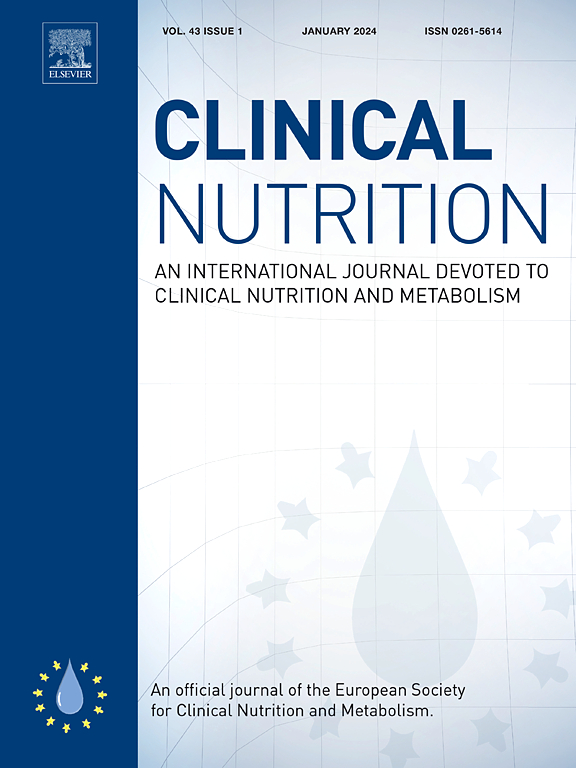Periconceptional maternal intake of ultra-processed foods, energy and macronutrients the impact on imaging markers of early utero-placental vascular development: The rotterdam periconception cohort
IF 7.4
2区 医学
Q1 NUTRITION & DIETETICS
引用次数: 0
Abstract
Background & aims
The quantity and quality of maternal nutrition in the periconception period is an important determinant for embryonic and foetal development and subsequent pregnancy course and outcome. The intake of ultra-processed foods (UPF) has increased worldwide and adverse health outcomes have been reported. However, the impact of UPF intake on the placenta, essential for prenatal nourishment, is unknown. Therefore, we aim to investigate associations between the periconceptional maternal intake of UPF, energy and related macronutrients, and first-trimester utero-placental vascular development.
Methods
We included 214 ongoing pregnancies in the Virtual Placenta study, a subcohort of the Rotterdam periconception cohort. At enrollment, participants filled out a food frequency questionnaire from which we calculated the average daily energy from UPF, total energy intake and macronutrient intake from UPF. At 7-9-11 weeks of gestation, we performed sequential three-dimensional power Doppler ultrasounds of the first-trimester utero-placental vasculature. Virtual Organ Computer-aided AnaLysis (VOCAL) software, Virtual Reality segmentation and a skeletonization algorithm were applied to measure placental volume (PV), utero-placental vascular volume (uPVV) and generate the utero-placental vascular skeleton (uPVS). Absolute vascular morphology was quantified by assigning a morphologic characteristic to each voxel in the uPVS (end-, bifurcation-, crossing- or vessel point) and used to calculate density of vascular branching. Linear mixed models adjusted for confounders were used to investigate associations between maternal intake of UPF, total energy and macronutrients from UPF and PV, uPVV and uPVS characteristics.
Results
Energy intake from UPF and total energy intake were not consistently associated with imaging markers of utero-placental vascular development. Higher carbohydrate intake of 10 g/day from UPF was associated with increased uPVS trajectories (end points (β = 0.34, 95%CI = 0.07; 0.61), bifurcation points (β = 0.38, 95%CI = 0.05; 0.70), vessel points (β = 0.957, 95%CI = 0.21; 1.71). No associations were observed with PV.
Conclusions
Against our hypothesis, periconceptional maternal intake of UPF and total energy were not convincingly associated with impaired first-trimester utero-placental vascular development. Remarkably, the increased intake of carbohydrates from UPF, which is often considered ‘unhealthy’, is positively associated with first-trimester utero-placental vascular development. Given the complexity of diet, further research should elucidate what underlies these findings to be able to interpret how nutrition may impact utero-placental vascular development in early pregnancy.
Clinical trial number
This study is registered at the Dutch Trial Register (NTR6854).
围孕期母体摄入超加工食品、能量和宏量营养素对早期子宫胎盘血管发育成像标志物的影响:鹿特丹围孕期队列
背景与ampamp;目的围孕期母体营养的数量和质量是胚胎和胎儿发育以及随后妊娠过程和结果的重要决定因素。全球范围内超高加工食品(UPF)的摄入量不断增加,有报道称这对健康产生了不利影响。然而,UPF 摄入量对胎盘的影响尚不清楚,而胎盘对产前营养至关重要。因此,我们旨在研究围孕期母体摄入的 UPF、能量和相关宏量营养素与第一胎子宫胎盘血管发育之间的关联。在注册时,参与者填写了一份食物频率调查问卷,我们从中计算出了来自UPF的日均能量、总能量摄入量和来自UPF的宏量营养素摄入量。在妊娠 7-9-11 周时,我们对第一胎子宫胎盘血管进行了连续的三维功率多普勒超声检查。应用虚拟器官计算机辅助分析(VOCAL)软件、虚拟现实分割和骨架化算法测量胎盘体积(PV)、子宫胎盘血管体积(uPVV)并生成子宫胎盘血管骨架(uPVS)。通过为uPVS中的每个体素(端点、分叉点、交叉点或血管点)分配一个形态特征来量化绝对血管形态,并用于计算血管分支密度。采用线性混合模型对混杂因素进行调整,以研究母体摄入的UPF、UPF总能量和宏量营养素与PV、uPVV和uPVS特征之间的关联。每天从UPF中摄入10克碳水化合物与uPVS轨迹(终点(β=0.34,95%CI=0.07;0.61)、分叉点(β=0.38,95%CI=0.05;0.70)、血管点(β=0.957,95%CI=0.21;1.71))的增加有关。结论与我们的假设相反,围孕期母体摄入的 UPF 和总能量与第一胎子宫胎盘血管发育受损没有令人信服的关联。值得注意的是,通常被认为 "不健康 "的UPF碳水化合物摄入量的增加与第一胎子宫胎盘血管发育呈正相关。鉴于饮食的复杂性,进一步的研究应阐明这些发现的基础,以解释营养如何影响孕早期子宫胎盘血管的发育。临床试验编号本研究已在荷兰试验注册中心注册(NTR6854)。
本文章由计算机程序翻译,如有差异,请以英文原文为准。
求助全文
约1分钟内获得全文
求助全文
来源期刊

Clinical nutrition
医学-营养学
CiteScore
14.10
自引率
6.30%
发文量
356
审稿时长
28 days
期刊介绍:
Clinical Nutrition, the official journal of ESPEN, The European Society for Clinical Nutrition and Metabolism, is an international journal providing essential scientific information on nutritional and metabolic care and the relationship between nutrition and disease both in the setting of basic science and clinical practice. Published bi-monthly, each issue combines original articles and reviews providing an invaluable reference for any specialist concerned with these fields.
 求助内容:
求助内容: 应助结果提醒方式:
应助结果提醒方式:


